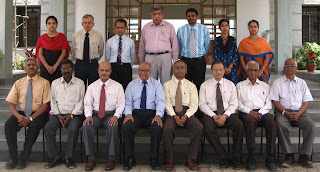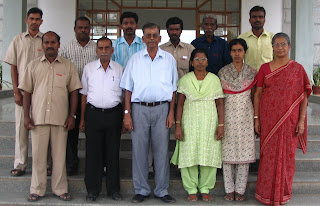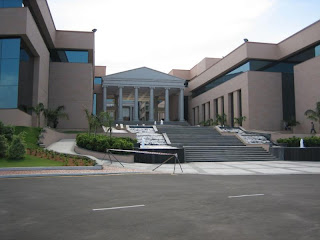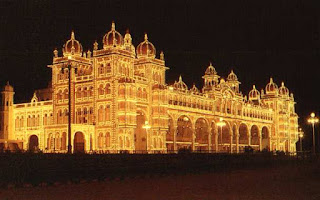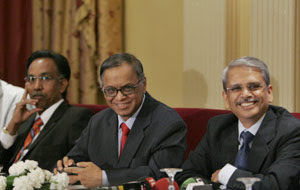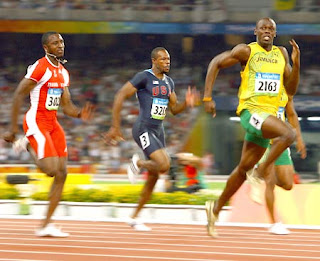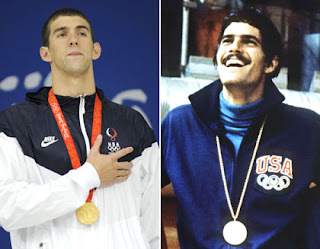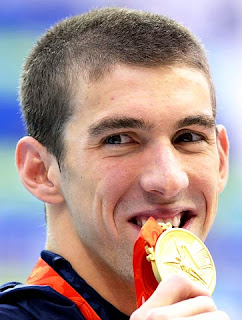Sisters and goddesses
by WILLIAM DALRYMPLE
Legend has it that it was the apostle, Thomas, the doubting one, who brought Christianity to Southern India - and now, aside from the odd jealous spat, the Virgin Mary and goddess Bhagavati are worshipped with equal fervourWilliam Dalrymple
The Guardian, Saturday June 28 2008
On the edge of the jungle lay a small wooden temple. It was late evening, and the sun had already disappeared behind the palms. The light was fading fast, and the hundreds of small clay lamps lined up on the wooden slats of the temple all seemed to be burning brighter and brighter, minute by minute.
The oiled torsos of the temple Brahmins were gleaming, too. They had nearly finished the evening ceremony - surrounding the idol of the goddess Bhagavati with burning splints as they rang bells, chanted and blew on conch shells. The ritual prepared the goddess for sleep.
Only when it was over, and the doors of the inner shrine were sealed for the night, were they able to tell me about the goddess they served. Bhagavati is the pre-eminent goddess in Kerala, the most powerful and beloved. In some incarnations, it was true, she could be ferocious: a figure of terror, a stalker of cremation grounds who slaughtered demons without hesitation or compassion. Some of her titles reflected this capacity: She Who Is Wrathful, She Who Has Flaming Tusks, She Who Causes Madness. But, in other moods, Bhagavati could be supremely benign and generous - the caring, loving, fecund mother - and this was how her followers usually liked to think of her. For many, she was the deity of the land itself: the spirit of the mountains, and the life force in the soil. In this form, Bhagavati is regarded as a chaste virgin and a caring mother, qualities she shares with her sister, whose enclosure lies a short distance down the road.
"Yes, yes, the Virgin Mary is Bhagavati's younger sister," explained Vasudeva, the head priest, matter of factly, as if stating the obvious.
"But, for sisters, don't they look rather different from each other?" I asked. A calendar image of the goddess, pinned up behind him, showed Bhagavati as a wizened hag wreathed in skulls and crowned with an umbrella of cobra hoods. In her hand she wielded a giant sickle.
"Sisters are often a little different from each other," he replied. "Mary is another form of the Devi. They have equal power." He paused: "At our annual festival the priests take the goddess around the village on top of an elephant to receive sacrifices from the people. She visits all the places, and one stop is the church. There she sees her sister."
"Mary gets on an elephant too?"
"No," he replied. "But when the goddesses visit each other, the sacrifice in the church is just like the one we have here: we light lamps and make an offering. The priests stay in their church, but the congregation of the church receives us, and makes a donation to the temple."
"So relations are good?"
"The people here always cooperate," he said. "Our Hindus go to the church and the Christians come here and ask the goddess for what they want - for everyone believes the two are sisters."
This was something I had seen for myself ever since I had arrived in Mannarkad, a small village 80km to the south of the Keralan capital, Trivandrum. In the large courtyard of the church - newly rebuilt and enlarged around a medieval core - many of the worshippers were Hindu rather than Christian.
"I have come here from 70km away," said KN Prakashan, a middle-aged school teacher. "Yes, I am a Hindu, but Mary is our holy mother. She is your mother and my mother, too. I believe she is a powerful goddess. Every time I come, I ask her to let the sufferings go from my life."
"And does she answer your prayers?"
"Of course," replied Prakashan. "It works. Otherwise I wouldn't be coming back here."
No less surprising were the Hindu customs practised by the church's congregation. The devotees coming in and out proudly told me that during the annual festival of Our Lady, the pilgrims would all take a ritual bath, shave their heads and eat only vegetarian food to purify themselves. They would join processions under torches, banners and coloured silk umbrellas of exactly the sort used by Hindus in their temple processions. The church also had a reputation for its powers of exorcism - the Christians sharing the Hindu belief that certain rituals can rid a possessed person of an unwanted spirit.
All this was mixed up with forms of devotion usually specific to the Orthodox churches. Booths along the side of the courtyard sold bronze plaques of arms, legs, eyes, hearts and other body parts to place in front of a holy icon to remind the saint to cure a particular ailment - something practised in Greek and Syrian Orthodox churches across the Levant.
The Christians seemed wholly at ease with the idea of praying alongside Hindus. "I believe Mary is more generous to the Hindus than she is to us," said Thomas Daniel as he prayed at the stone cross at the back of the enclosure. "Yes, we also believe Bhagavati and Mary are twin sisters."
"So you believe in the Hindu gods, too?"
"Yes, of course. Those gods are there. I go to the temple with my Hindu friends, though I don't tell the priests. And I participate in their festivals, though I don't give offerings." Thomas smiled: "This has been passed from generation to generation... All the people of Kerala believe in all of the gods."
Kerala is the greenest state in India: hot and humid, still and brooding. The soil is so fertile that as you drift up the lotus-choked backwaters around Mannarkad, the trees close in around you, a vault of palm and bamboo. Mango trees hang heavy over the fishermen's skiffs. All around this central part of Kerala live the St Thomas Christians - so called because they believe that St Thomas, the apostle of Jesus who famously refused to believe in the resurrection "until I have placed my hands in the holes left by the nails and the wound left by the spear", came to India from Palestine after the resurrection, and that he baptised their ancestors.
Over the centuries, almost every western traveller to southern India, from Marco Polo to the first Portuguese conquistadors, told the same story of Thomas' missionary journey. According to the Anglo-Saxon Chronicle, King Alfred sent Bishop Sighelm of Sherborne "to St Thomas in India"; years later the bishop returned, carrying with him "precious stones and the odiferous essences of that country". In Kerala, St Thomas is said to have converted the upper caste Brahmins with the aid of miracles and to have built seven churches.
Whatever the historical truth, there can be no doubt that Christianity has deep roots in the soil, in all probability stretching back to the first century AD. Over the centuries of unusually close coexistence, the Hindus and the Christians of the region have found their myths and their rituals fusing slowly together. There may be violence between Christians and Hindus in some parts of northern India, but there has never been any serious tension between the two faiths here in Kerala. Until recently, the St Thomas Christians were awarded places of honour in the great temple processions and the churches were allowed to borrow the temple elephants for their own festivals.
When the Portuguese arrived in India in the 16th century they criticised the St Thomas Christians' clergy for the many "pagan" practices they had adopted: ritual ablutions, the casting of horoscopes in the Hindu manner, the belief in the transmigration of souls - traditions which survived into the 20th century, some of them still common today.
The same fusion of Hinduism and Christianity is seen in the Christian art of Kerala. Every church in the region has a large stone cross in its churchyard; but these unambiguously Christian symbols rise out of lotus-shaped Hindu bases, decorated with lion-headed, fish-bodied makaras, cows, elephants, tigers and dancing girls. Paired peacocks are especially popular, doubling as they do as eucharistic symbols and vehicles of the god Murugan, son of Shiva.
At the village of Angamally, near Kochi's airport, there is a 17th-century wall painting in the church which reveals something of the complexity of the relationship between the two faiths. It is in many ways a conventional hell scene, paired with the Last Judgment facing it across the nave, but there are many idiosyncrasies. The devil is made to resemble the goddess Kali, with her tongue stuck out, a crown of snake heads above and a trident in one hand. To the side, what could be either a Portuguese Catholic priest or a money lender - he is wearing priest robes and holding a big bag of money - is being tortured; the floor of hell is slithering with king cobras, and a blue-skinned elephant is busy crushing sinners.
Today, even if St Thomas is no longer carried in temple processions, in village after village the shared myths and festivals survive. Even the story of St Thomas' martyrdom has been fused with Hindu myth, so St Thomas is said to have met his end in Mylapore, south of Chennai, while hiding from his enemies in the form of a peacock, the sacred bird of the nearby Mylapore temple.
In Puthupally, near Kottayam, the villagers associate St George - the saint the English think of as their own patron - with the goddess they say is his sister: the dark Kali, whose temple lies to the side of the church. In the church, St George is shown killing a dragon; in the temple his sister Kali is sculpted slaughtering a demon in the form of a water buffalo. Both brother and sister are believed locally to be ferocious carnivores, and during festivals both are fed the blood of decapitated chickens.
Not far away, at Piravam, Shiva is locally celebrated as the travelling companion of the Three Wise Men. According to local myth, the four went on a long pilgrimage and became close friends during the course of their journey. Elsewhere, there are tales of friendships struck up between Krishna and St Sebastian, believed locally to be a Keralan Brahmin who was converted to Christianity by St Thomas.
Not that relations between Christian saints and Hindu deities are always unproblematic. There is a story of St Thomas and the goddess Bhagavati having a spat, with St Thomas chasing the goddess to her temple at Kodangallur, and sticking his foot in the door to prevent her locking him out. Even in Mannarkad, it is said that the crack in the church's bell is due to Bhagavati damaging it as its tolling was waking her up during her sleep. In retaliation, the Virgin Mary is believed to have cracked one of the sacred conches at her sister's temple.
Such myths may hint at periods of tensions between the different faiths, and certainly there are those today who frown on the extreme porousness of religious practice in the region. The Christian clergy at the church of Mannarkad, while welcoming Hindus into the church, do all they can to stop their own Christian flock from visiting the temple. When I asked the local priest, Fr Kuriakos, about the forthcoming visit of the goddess Bhagavati to the church to see her sister, he made it clear that he would on no account be present to welcome the goddess. "The Virgin Mary comes from Jewish tradition," he said, clearly exasperated. "She is the daughter of Joachim and Anna, and was from Palestine, not India."
He paused, looking me in the eye: "There is no relation between the Virgin Mary and Bhagavati," he said. "We cannot encourage this belief. It is a myth. Worse, it is nonsense."
With the noise of firecrackers exploding, six cymbal clashers clashing, 12 temple drummers drumming, and the women of the village loudly ululating, the procession set off up the dirt track behind the temple and into the jungle. It was 8.30 on the morning of January 6 2008, and the goddess Bhagavati, in the form of a silver image hoisted on to a wonderfully caparisoned temple elephant, was setting off to visit her devotees and relations across the village of Mannarkad. From the top of her mount, the goddess looked down in splendour at her devotees, her eyes bulging in her rounded skull-like face, her skeletal teeth and fangs grinning with pleasure. This ceremony had been carried out in the village for hundreds of years.
As we walked along the village boundary, through pepper and rubber plantations, groups of devotees were waiting for the annual visit of their deity. Trestle tables had been loaded with burning lamps and offerings - coconuts and bananas, baskets of puffed rice and jaggery. Each time the elephant stopped, offerings would be given and blessings received. Then more firecrackers would be let off - scaring the children and grazing goats - and on the procession would trundle.
"She is the mother of the village," said Saraswati Amma, an old lady waiting on her verandah for the goddess, with her grandchildren around her.
"In ancient times, this was forest," said her son, Anish, holding his youngest boy in his arms. "We needed the goddess to guard against bad spirits. They are still here, hiding in the forest, and we need her to keep them at bay."
"Everyone in the village gives her something," said Saraswati. "Even if the Christians sometimes do it in secret."
The site of the final sacrifice has always been located at the back of the church, in the Christian area of the village. A small platform was prepared, crisscrossed with bamboo, incense sticks placed at each corner. When the goddess drew near, the priests blew their conch shells and the drummers increased their tempo. The camphor was lit, Sanskrit slokas were recited, and the bamboo grid doused with the blood-coloured guruthi.
"We used to sacrifice a rooster," said one of the onlookers, a Hindu shopkeeper named Raji. "But that is stopped now."
"From time immemorial the sacrifice has taken place here by the church," said his wife, Susheela, "where the Devi fought and defended the village."
"I have always heard that the two Devis of the village are sisters," said Raji. "If you go to the temple you must also go to the church, otherwise one of the sisters will be jealous."
"It's true," said Susheela. "They say that if you want your prayers answered you must pray at both the temple and the church. They say that if you light a lamp at the temple, that light also can be seen flickering in the church, and vice versa. The two are really one." ·
..........................................
· William Dalrymple is the author The Last Mughal: The Fall Of A Dynasty, Delhi, 1857 (Bloomsbury)
· This article was amended on Saturday July 5 2008. The capital of Kerala is not Kochi as we said in the article above, but Thiruvananthapuram, also known by its anglicised name Trivandrum. This has been corrected.
